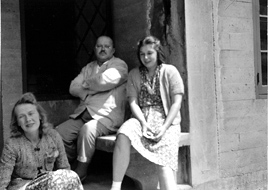1940: Permeability and the Nature of Cell Membranes, Vol. VIII
Organizer: Eric Ponder
This was the last Symposium that Eric Ponder organized and it is not surprising that he chose a topic close to his heart. Ponder had carried out a variety of biophysical studies on the red blood cell, for example, examining the changes in blood cell shape as the cells were hemolysed by addition of water, and had published the standard monograph on the red blood cell.
The majority of papers in this Symposium also used the erythrocyte as a model system and examined the transfer of molecules of various sorts across the membrane. It was hoped that the properties of these molecules, for example their solubility in lipids, would correlate with their effects on cells, and thus provide insights into the nature of the cell membrane and its structure. But, at this time, models of membrane structure were rather sparse and only two or three papers at the Symposium were concerned with experiments directly examining the constituents of the membrane. Francis Schmitt, for example, had carried out X-ray diffraction studies of lipids and lipid-proteins mixtures, but with inconclusive results. M. Kopac was one of the few participants who worked on cells with surfaces more complicated than that of the erythrocyte; he presented data on the eggs of marine invertebrates.
One participant was Hugh Davson who, with his colleague J. F. Danielli, had developed a very influential model of the membrane based on the permeability studies that so occupied participants in the Symposium. Their model, which was in vogue from the mid-1930s until the 1960s, proposed that the membrane was a hydrophobic lipid bilayer coated on both sides by hydrophilic proteins.
Another notable participant was Robert
| 
F. Furchgott, then a graduate student, who was attending his third Symposium. He gave a paper describing his attempts isolate the protein component of the red cell membrane. Furchgott was to share the 1998 Nobel Prize for Physiology or Medicine for his work on nitric oxide, 60 years after his first Symposium! In his Nobel lecture, Furchgott explained how Ponder had arranged for him to pay for his board and lodging by managing the lantern slide projector at the lectures.
This does not seem to have been one of the more popular Symposia; there were 41 participants and 28 presentations, compared with 57 and 36 in 1939. It reflected, perhaps, a decline in interest in the field, a decline that was mirrored by the state of biophysical research at the Biological Laboratory. While the annual report listed several investigators, these were mainly summer visitors at the Symposia; Fricke and Ponder were the only full-time researchers and by 1940 Fricke and two full-time support staff had left. Ponder left in 1941 and Demerec became director, signaling a change in research emphasis to genetics. — Jan A. Witkowski |